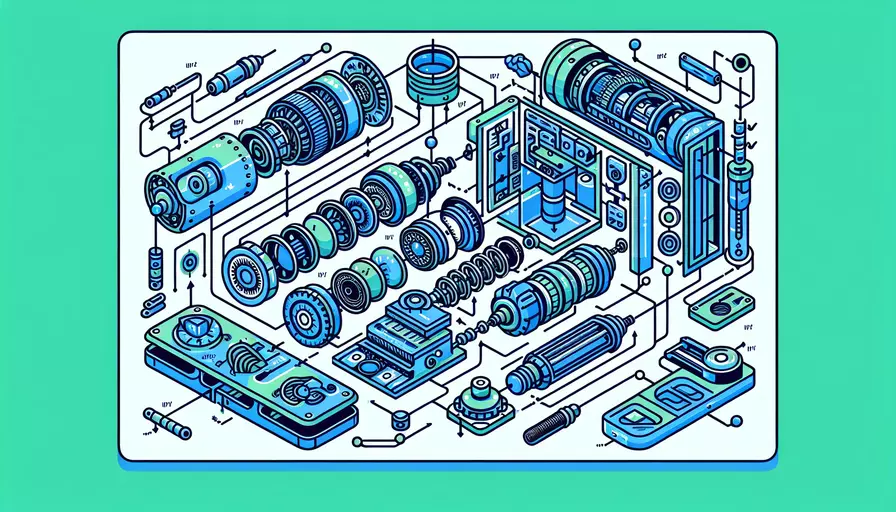
在Vue.js开发中,封装组件是一项非常重要的技能。1、封装组件可以提高代码的可重用性,2、简化应用的维护,3、提高开发效率。 下面将详细介绍一些常见的Vue组件封装方法及其应用。
一、定义组件的基础方法
在Vue中,定义组件有多种方法。最常见的有两种:全局注册和局部注册。
- 全局注册
Vue.component('my-component', {template: '<div>A custom component!</div>'
});
- 局部注册
export default {components: {
'my-component': {
template: '<div>A custom component!</div>'
}
}
}
全局注册的组件可以在任何地方使用,而局部注册的组件只能在定义它们的父组件中使用。
二、常见的Vue组件封装
1、输入框组件
输入框是前端开发中最常见的组件之一。封装一个通用的输入框组件,可以大大简化表单的开发。
<template>
<div class="input-wrapper">
<input
:type="type"
:value="value"
@input="$emit('input', $event.target.value)"
/>
</div>
</template>
<script>
export default {
props: {
value: String,
type: {
type: String,
default: 'text'
}
}
};
</script>
<style scoped>
.input-wrapper {
margin: 10px 0;
}
</style>
2、按钮组件
按钮组件也是非常常见的,封装一个通用的按钮组件,可以提高代码的可维护性。
<template>
<button :class="['btn', btnType]" @click="$emit('click')">
<slot></slot>
</button>
</template>
<script>
export default {
props: {
btnType: {
type: String,
default: 'primary'
}
}
};
</script>
<style scoped>
.btn {
padding: 10px 20px;
border: none;
cursor: pointer;
}
.btn.primary {
background-color: blue;
color: white;
}
.btn.secondary {
background-color: gray;
color: black;
}
</style>
三、封装复杂组件
1、表格组件
表格组件在企业级应用中非常常见,封装一个通用的表格组件,可以大大提高开发效率。
<template>
<table>
<thead>
<tr>
<th v-for="col in columns" :key="col">{{ col }}</th>
</tr>
</thead>
<tbody>
<tr v-for="row in rows" :key="row.id">
<td v-for="col in columns" :key="col">{{ row[col] }}</td>
</tr>
</tbody>
</table>
</template>
<script>
export default {
props: {
columns: Array,
rows: Array
}
};
</script>
<style scoped>
table {
width: 100%;
border-collapse: collapse;
}
th, td {
border: 1px solid #ddd;
padding: 8px;
}
</style>
2、模态框组件
模态框组件也是非常常见的,封装一个通用的模态框组件,可以提高代码的复用性。
<template>
<div v-if="visible" class="modal">
<div class="modal-content">
<span class="close" @click="$emit('close')">×</span>
<slot></slot>
</div>
</div>
</template>
<script>
export default {
props: {
visible: {
type: Boolean,
default: false
}
}
};
</script>
<style scoped>
.modal {
display: block;
position: fixed;
z-index: 1;
left: 0;
top: 0;
width: 100%;
height: 100%;
overflow: auto;
background-color: rgb(0,0,0);
background-color: rgba(0,0,0,0.4);
}
.modal-content {
background-color: #fefefe;
margin: 15% auto;
padding: 20px;
border: 1px solid #888;
width: 80%;
}
.close {
color: #aaa;
float: right;
font-size: 28px;
font-weight: bold;
}
.close:hover,
.close:focus {
color: black;
text-decoration: none;
cursor: pointer;
}
</style>
四、组件间的通信
在Vue中,组件间的通信主要有以下几种方式:
-
Props和自定义事件
父组件通过props向子组件传递数据,子组件通过自定义事件向父组件发送消息。
// 父组件<my-component :value="parentValue" @input="parentValue = $event"></my-component>
// 子组件
<template>
<input :value="value" @input="$emit('input', $event.target.value)">
</template>
<script>
export default {
props: {
value: String
}
};
</script>
-
Vuex
Vuex是Vue.js的状态管理模式,适用于多组件共享状态的场景。
// store.jsexport default new Vuex.Store({
state: {
count: 0
},
mutations: {
increment (state) {
state.count++
}
}
});
// 组件中使用
<template>
<div>{{ count }}</div>
<button @click="increment">Increment</button>
</template>
<script>
import { mapState, mapMutations } from 'vuex';
export default {
computed: mapState(['count']),
methods: mapMutations(['increment'])
};
</script>
-
Provide/Inject
Provide和Inject主要用于祖先组件与后代组件间的通信。
// 祖先组件<template>
<my-child></my-child>
</template>
<script>
export default {
provide: {
message: 'Hello from ancestor'
}
};
</script>
// 后代组件
<template>
<div>{{ message }}</div>
</template>
<script>
export default {
inject: ['message']
};
</script>
五、实战案例
1、封装一个带有验证功能的输入框组件
<template>
<div class="input-wrapper">
<input
:type="type"
:value="value"
@input="handleInput"
@blur="validate"
/>
<span v-if="error">{{ error }}</span>
</div>
</template>
<script>
export default {
props: {
value: String,
type: {
type: String,
default: 'text'
},
validator: Function
},
data() {
return {
error: null
};
},
methods: {
handleInput(event) {
this.$emit('input', event.target.value);
if (this.error) {
this.validate();
}
},
validate() {
if (this.validator) {
this.error = this.validator(this.value);
}
}
}
};
</script>
<style scoped>
.input-wrapper {
margin: 10px 0;
}
input {
border: 1px solid #ccc;
padding: 5px;
}
span {
color: red;
font-size: 12px;
}
</style>
2、封装一个带分页功能的表格组件
<template>
<div>
<table>
<thead>
<tr>
<th v-for="col in columns" :key="col">{{ col }}</th>
</tr>
</thead>
<tbody>
<tr v-for="row in paginatedRows" :key="row.id">
<td v-for="col in columns" :key="col">{{ row[col] }}</td>
</tr>
</tbody>
</table>
<button @click="prevPage" :disabled="currentPage === 1">Previous</button>
<button @click="nextPage" :disabled="currentPage === totalPages">Next</button>
</div>
</template>
<script>
export default {
props: {
columns: Array,
rows: Array,
rowsPerPage: {
type: Number,
default: 10
}
},
data() {
return {
currentPage: 1
};
},
computed: {
totalPages() {
return Math.ceil(this.rows.length / this.rowsPerPage);
},
paginatedRows() {
const start = (this.currentPage - 1) * this.rowsPerPage;
const end = start + this.rowsPerPage;
return this.rows.slice(start, end);
}
},
methods: {
prevPage() {
if (this.currentPage > 1) {
this.currentPage--;
}
},
nextPage() {
if (this.currentPage < this.totalPages) {
this.currentPage++;
}
}
}
};
</script>
<style scoped>
table {
width: 100%;
border-collapse: collapse;
}
th, td {
border: 1px solid #ddd;
padding: 8px;
}
button {
margin: 5px;
padding: 5px 10px;
}
</style>
六、总结与建议
封装组件不仅可以提高代码的复用性,还可以大大简化应用的维护和开发过程。通过封装常用的组件,如输入框、按钮、表格和模态框等,可以使代码更加简洁和易于维护。
主要观点总结:
- 封装组件可以提高代码的可重用性、简化应用的维护、提高开发效率。
- 常见的组件封装包括输入框、按钮、表格和模态框等。
- 组件间的通信主要通过Props、自定义事件、Vuex以及Provide/Inject等方式实现。
进一步建议:
- 在项目初期,尽量封装常用组件,减少重复代码。
- 使用Vuex管理状态,适用于复杂的多组件状态共享场景。
- 保持组件的单一职责,确保每个组件只完成一项任务。
通过不断实践和优化,您将能够封装出更加高效和实用的Vue组件,为项目的开发和维护带来极大的便利。
相关问答FAQs:
1. 什么是Vue组件的封装?
Vue组件的封装是指将一部分可复用的代码和功能封装成一个独立的组件,以便在Vue应用程序中多次使用。这样的封装可以提高代码的可维护性和可重用性,同时也可以提高开发效率。在Vue中,组件可以是页面中的一部分,也可以是整个页面。
2. 有哪些常见的Vue组件可以进行封装?
在Vue中,可以对各种类型的组件进行封装,以满足不同的需求和场景。一些常见的Vue组件封装包括:
- 表单组件:例如输入框、下拉框、单选框、复选框等。这些组件可以封装验证逻辑和数据处理逻辑,使得表单的开发更加方便和高效。
- 列表组件:例如表格、列表、轮播图等。这些组件可以封装数据渲染和交互逻辑,使得页面的展示更加灵活和可定制。
- 模态框组件:例如弹窗、提示框、确认框等。这些组件可以封装常用的对话框功能,提供统一的用户体验。
- 导航组件:例如导航栏、面包屑、侧边栏等。这些组件可以封装路由和导航逻辑,方便页面之间的跳转和导航。
3. 如何封装一个Vue组件?
封装一个Vue组件可以按照以下步骤进行:
- 创建一个Vue组件的文件,可以是一个单文件组件(.vue)或者一个普通的JavaScript文件。
- 在文件中定义组件的模板(template)、样式(style)和逻辑(script)。
- 使用Vue的组件选项(例如data、methods、computed等)定义组件的行为和功能。
- 在需要使用该组件的地方,通过import语句导入组件,并在Vue实例中注册该组件。
- 在模板中使用该组件,通过标签的形式引入,并传递必要的props和事件。
例如,下面是一个简单的Vue组件封装的示例:
<template>
<div>
<input v-model="inputValue" type="text" placeholder="请输入内容">
<button @click="handleClick">提交</button>
</div>
</template>
<script>
export default {
data() {
return {
inputValue: ''
}
},
methods: {
handleClick() {
// 处理点击事件
console.log('提交的内容为:', this.inputValue);
}
}
}
</script>
<style scoped>
/* 样式定义 */
</style>
通过这样的方式,我们可以封装出各种复杂的Vue组件,以满足不同的业务需求。
文章标题:封装过什么vue组件,发布者:不及物动词,转载请注明出处:https://worktile.com/kb/p/3519935

 微信扫一扫
微信扫一扫  支付宝扫一扫
支付宝扫一扫 